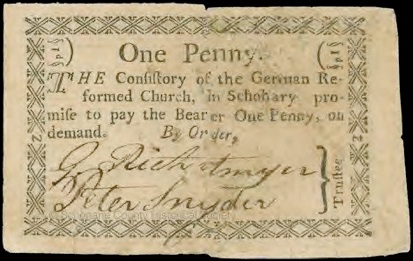Historical money equivalents

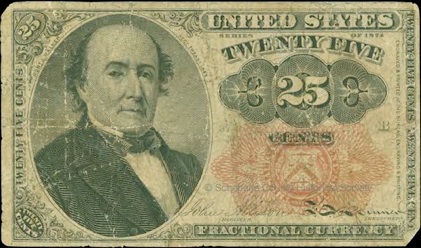

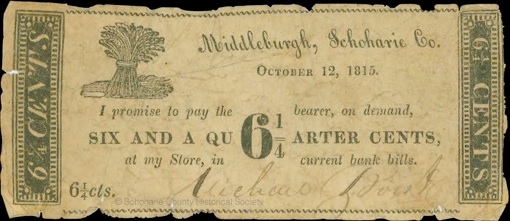
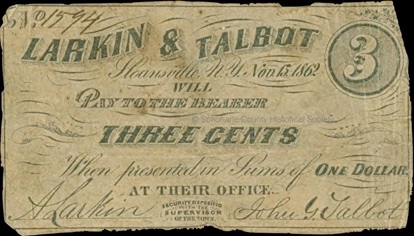
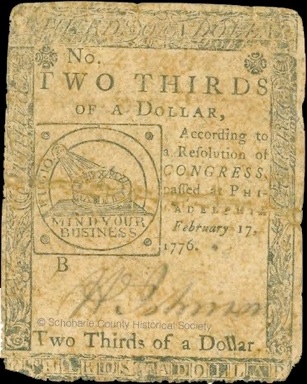
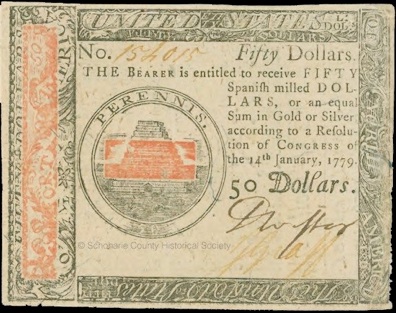
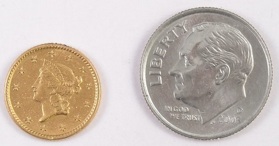
1853 gold $1 coin compared to a modern dime
loaned by Allan Cross
Continental Currency
(left) Two Thirds of a Dollar note [1½ shillings or 1s/6d sterling], 1776
(above) 50 Dollar note, 1779 Mahar collection, Old Stone Fort
Store Notes and Tokens
Stores and merchants also issued change in the form of promissory notes and copper or brass tokens, redeemable at their store or sometimes a local bank. These might also circulate among local farmers and businesses in a cash-poor economy, but were virtually worthless anywhere else.
Museum Collection
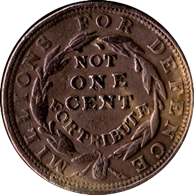
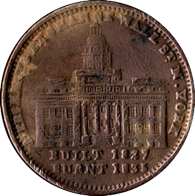
Schoharie County Bank Note, One Dollar, 1861
Until the Civil War, the Federal government minted coins of copper, silver and gold, but did not issue paper currency. Banks printed their own notes, which were redeemable in coins (specie), but backed only by the assets of that bank. Their real value declined according to the distance from the bank. Panics, what we call recessions, occurred when people lost confidence and rushed to redeem notes that exceeded banks’ hard currency reserves, causing the banks to fail.
Museum Collection
US Fractional Currency Note, 25 cents, 1874
During the Civil War, the Federal government began printing paper currency. These small-denomination notes were scorned by hard-money advocates as “shinplasters.” Remember that today’s equivalent would be about $12.50. You couldn’t exchange this for a real quarter, you had to collect 12 of them to get three dollar bills ($150 today), which were then redeemable in silver. No wonder they were unpopular!
Now all our money is token money,
worth only what governments (and commodities traders) say it is.
At the moment it might be said that the world is on a US Dollar standard. Governments manipulate the money supply to stimulate growth or slow inflation. Presumably this flexibility softens the impact of financial downturns, a theory that is being tested right now.
There are those who advocate a return to the perceived discipline and stability of a precious metal standard. But is that practical in the new century when fortunes can be made or lost electronically more quickly than one could hand a microscopic gold coin to a cashier for a cup of coffee?
Remember, for money to work everyone has to agree on its value.
Church-Money, One Penny, 1792
Counterfeiting had become such a problem in New York that copper coins lost all value by 1791. The German Reformed Church of Schoharie [now the Old Stone Fort Museum] issued this note for One Penny (1d NY currency = ½d sterling or 1¢). A parishioner would barter something to the Church or perhaps give a silver half-real to receive 6 of these for local purchases or to place one or two in the collection plate each Sunday.
Donated by Michael West Family, Museum collection
PAPER MONEY
WHY PAPER CURRENCY?
Coins of precious metal are difficult to manage. They were hoarded during hard times, and were heavy and costly to transport long distances. (Think of treasure chests.) Small denominations of silver or gold were tiny and easy to lose. The $1 gold coin, equivalent to $50 in today’s money, was smaller than a half dime, which was itself smaller than a dime! Paper is far more convenient, as long as everybody agrees on its value.
NOT WORTH A CONTINENTAL
We have already seen that colonial paper currency had substituted for scarce coins. However, during the War of Independence the Continental Congress authorized the printing of far more Continental currency than could be backed by hard coins, since most of the coinage was borrowed from allies like Spain and France. This caused wartime inflation that devalued the Continental notes and made it impossible for the new country to pay its war debts. Under the Articles of Confederation, Congress could not even tax to raise money - that’s what the war had been fought over! So Continental paper currency became virtually worthless and people lost confidence in paper. Think "junk bonds."
NY Mercantile Exchange token, 1¢, circa 1835
Museum Collection
6 ¼ cents is one-sixteenth of a dollar (one-fourth of a quarter) about $3.13 today.
